The engineer shall strictly test the Tungsten Carbide powder purchased from the supplier.
They will test the tungsten carbide powder from the physical and chemical aspects.
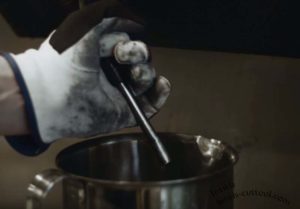
Carbon quantity control is the core of cemented carbide quality. At present, no matter in large or small factories;
If the carbon content can be controlled to a fine, I think, do not change the current process; Do not increase the cost; do not add equipment premise, can make the product quality promotion a step.
From “control,” if the relative saturation of cemented Carbide is well controlled, the carbon content of cemented Carbide is well controlled. Control of the hard alloy’s stubborn magnetic force, the alloy’s grain size is well controlled.
If the density of the alloy is well controlled, the composition, grain size, carbon content, structure, and porosity of the composite are well controlled. The quality of the alloy makes it impossible for it not to be good.
Cemented Carbide is composed of refractory metal carbide and bonded metal. One of the refractory metal carbides, such as carbonization Tungsten, titanium carbide, tantalum carbide, niobium carbide, and vanadium carbide is not magnetic materials, only bonded metal cobalt, nickel, and other ferromagnetic materials, in the external magnetic field will show magnetic characteristics. Cobalt magnetism is a component sensitive parameter.
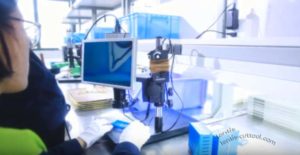 When the sample magnetized in a stable magnetic field, the induced current will be generated in the induction coil of the measuring device, and the magnetic saturation state will be measured
When the sample magnetized in a stable magnetic field, the induced current will be generated in the induction coil of the measuring device, and the magnetic saturation state will be measured
The saturation magnetization of the sample can be calculated by using the induction current of 0.5%, and the total amount of the magnetizable cobalt phase in the sample can be calculated by converting the saturation magnetic field intensity into the total amount of cobalt phase in the example.
The coercivity of cemented carbides is a tissue-sensitive parameter related to technical magnetization. It is related to the content of cobalt in the bonded phase, the crystal, the shape and dispersion of cobalt, the lattice distortion of cobalt, the internal stress, and the presence or absence of impurities.
In general, the coercivity of cemented carbides decreases with the increase of cobalt content,
the higher the coercivity is, the higher the coercivity is, so the coercivity can be used as a parameter to measure the grain size of tungsten carbide indirectly when HC is too low, carburization may occur, and when HC value is too high, carbon deficiency or decarburization may occur.
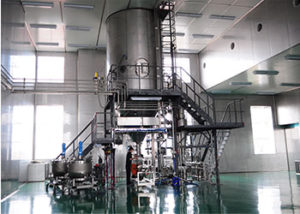 The measurement of the coercivity of cemented carbides is of considerable significance to the technology. it was using the correlation between the COERCIVITY HC and other physical parameters such as hardness, density, cobalt magnetism, etc. , it can play an active monitoring role in the production process of cemented Carbide.
The measurement of the coercivity of cemented carbides is of considerable significance to the technology. it was using the correlation between the COERCIVITY HC and other physical parameters such as hardness, density, cobalt magnetism, etc. , it can play an active monitoring role in the production process of cemented Carbide.
If you visit your suppliers, it’s hard to say how well they can control the quality of their products if they don’t have the equipment to test cobalt magnets.
In addition, staff professional quality training, production environment is an essential factor leading to quality problems.
Raw materials generally consist of 80% tungsten carbide powder and 20% micronutrient.
A blade usually takes 48 hours to produce.
Milling Room wet Grinding
Etoh 2O and some other natural bonding phase .10 to 24 hours.
After the wet Grinding, it goes to the next step, the spray drying tower.
The previous Etoh and H20 will evaporate during this process.
 Some of your suppliers may not have this spray drying tower because of its high price.
Some of your suppliers may not have this spray drying tower because of its high price.
The smaller ones cost around 300 million RMB.
This equipment makes the powder more uniform and beautiful, such powder after pressing forming, not easy delamination, or carburization and other problems.
The next procedure is the press, a large-tonnage fully automatic press generally in 16-20tons.
One of the key things involved in pressing is the mold.
Mold types were categorized as General Mold and 3R mold. The standard die has two kinds of sinking hole and square hole. With pneumatic core Rod, the length of the core rod is 180mm, the upper punch has an emotional punch, and the die holder equipped with a pneumatic core rod device. Straight hole die is generally without back angle die, the use of core Rod, core rod length 220mm, the use of straight hole kills frame, with fixed core rod device, general production pay blade.
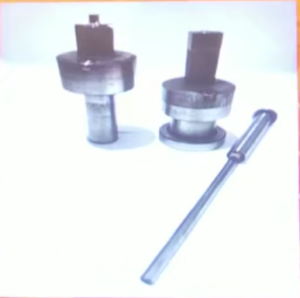 Compared with the typical mold, the 3R shape has a significant difference in the mold body size, punch, and core rod structure. 3r mold body size 70X 106mm, clamping height 25mm, there are a pair of the screw hole and a pair of positioning hole, 10mm for positioning pinhole, production use of unique screw pin, eight anti-fixing screw hole, using a standard screw.
Compared with the typical mold, the 3R shape has a significant difference in the mold body size, punch, and core rod structure. 3r mold body size 70X 106mm, clamping height 25mm, there are a pair of the screw hole and a pair of positioning hole, 10mm for positioning pinhole, production use of unique screw pin, eight anti-fixing screw hole, using a standard screw.
The die body, punch, and core rod are made of hard alloy. Generally, the die body is made of a tungsten-cobalt alloy containing about 11% cobalt, and the punch is made of a tungsten-cobalt alloy containing approximately 15% cobalt.
Die Shrinkage determining principle
1. Principle 1, the blank die is larger than 1 / 2′(12.7 mm) according to the maximum line size of the blank
Select 18% shrinkage, less than 1 / 2′(12.70 mm) select 17% shrinkage;
2. Principle 2, according to the maximum density of the blank without delamination crack, the Shrinkage of the die is selected
3. 3. Principle 3, the blank with complicated geometry shape and difficult to form with stress concentration can be pressed with a higher shrinkage ratio, and the dies mainly used for producing cermet and ultra-fine grain can also be considered with a higher shrinkage ratio
Mold making process, mold shrinkage is generally determined by the manufacturer; the main basis is to see the manufacturer’s process, is Paraffin, or peg. In order to avoid cracks and delamination, the product needs a proper size.
 There are a lot of people who want to understand cemented Carbide, and this Shrinkage is critical to why the final product is so different from the size of the blank.
There are a lot of people who want to understand cemented Carbide, and this Shrinkage is critical to why the final product is so different from the size of the blank.
Some customers received alloy products that have cracks and delamination, generally think of the product raw materials above, but the mold is also a large part of the reason.
The factory focus to improve the quality, most of them buy the automatic presses. Yea and the small and medium enterprises using cold isostatic pressing. The kind of hydraulic presses that are still used by humans has eliminated.
The hydraulic press can not guarantee the precision of Products; buyers seeking cost-effective may prefer a more labor-intensive factory. The automatic press equipment is not only high precision, but the service life is also generally five times the ordinary press, costs will be lower in the long run.
After pressing the blank will be weighed by professional operators, for the initial testing.
 The rough that’s just been pressed, it’s fragile. It needs to sinter. On the surface of a vacuum pressure furnace
The rough that’s just been pressed, it’s fragile. It needs to sinter. On the surface of a vacuum pressure furnace
The temperature at 1500. Facility temperature.
The temperature of the Blade is very high after blowing in the furnace, and the size of the edge after sintering is 1 / 2 of the original one.
Once the Blade is out, get the exact dimensions and shape, and tolerance. The Blade will be grinding on different CNC machines one by one.
With a cutting fluid
CVD Chemical Vapour deposition
PVD Physical Vapour deposition
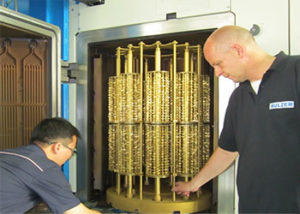 The PVD device automatically loads a large piece and then PVD
The PVD device automatically loads a large piece and then PVD
It makes the Blade harder and stronger. More resilient.
And the Blade can be colored throughout the process. Certain colors.
The PVD program manufactured and manually tested, then packaged.
Packaging equipment.

Leave A Comment